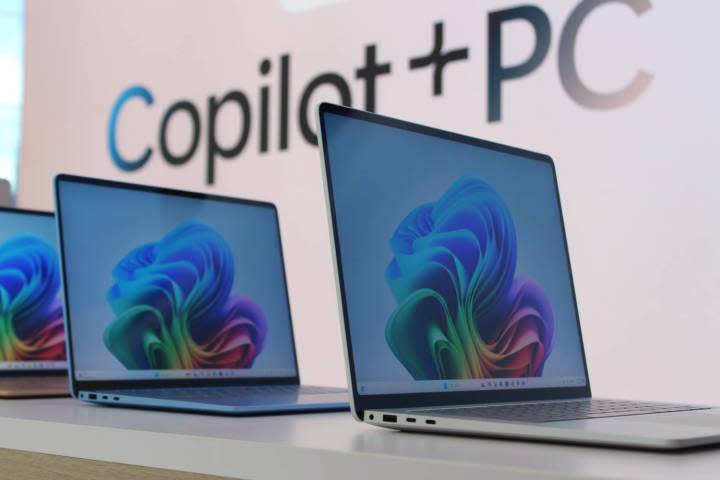AMD just won the AI arms race

TOPS — also known as trillions of operations per second.
The acronym has quickly become the go-to measurement for expressing the AI horsepower of a system, and the biggest tech companies in the world are duking it out to outdo each other.
Microsoft really kicked things off with the requirement of a 40 TOPS NPU, but AMD just launched its new Strix Point Ryzen AI processors — and they’re the real deal. AMD is the first to launch capable NPUs (neural processing units) in systems that also have discrete GPUs on board — and that’s a game-changer.
The battle over TOPS begins

Microsoft’s push into on-device has meant a rapid increase in the performance of NPUs. The new hardware was first introduced in Intel’s Meteor Lake chips, which could handle just 10 TOPS. The acronym is quickly becoming the go-to way to measure the AI horsepower of a system, standing for trillions of operations per second. As it turns out, those 10 TOPS weren’t all that useful in these initial laptops, despite being marketed as “AI PCs.” It just wasn’t enough performance to be favored over the CPU or GPU in most tasks.
The jump to 40 TOPS in Copilot+ PCs is important, especially for background tasks like the new Recall feature. As Microsoft and Qualcomm noted, that NPU is critical to producing devices with long battery life too. That’s because the initial group of laptops under the Copilot+ PC banner all belong to the same class of laptop. These are highly portable MacBook Air competitors meant for light work on the go.
But let’s get real — the most powerful AI PC in the world is never going to be a device without a powerful GPU. Despite what Microsoft has been saying, GPUs remain the most important component in raw AI performance. Modern graphics cards have loads of AI power under the hood, thanks to the Nvidia’s heavy investment in the technology early on. And that’s what makes these new AMD laptops so exciting. They combine a 50 TOPS NPU with an additional 320 TOPS of the RTX 4070 — all in a stunningly sleek package. The NPU can handle the lighter background tasks, but as of now, you still need a GPU to handle more-intensive AI tasks, especially ones in content creation applications.

For me, the star of the lineup of the first Ryzen AI laptops is the Asus ProArt P16. While devices like the new Surface Laptop 13 are a solid alternative to the M3 MacBook Air, they’re not meant to compete with the MacBook Pro. But that’s exactly what the ProArt P16 looks to do. Despite having the new Ryzen AI 9 HX chips and up to an RTX 4070, the device is just 0.59 inches thick. You read that right — the ProArt P16 is considerably thinner than the 16-inch MacBook Pro. There’s been plenty of attempts at creating MacBook Pro alternatives recently, but none that undercut its design in this way.
Even beyond that, the ProArt P16 is only marginally thicker than the Qualcomm-powered Copilot+ PCs, despite having way more headroom for GPU and AI performance. For some, it’s within 0.02 inches.
As a sidenote, the design is extremely modern, using a massive trackpad and some oversized stereo speaker grills flanking the keyboard. It even has a high-resolution OLED panel.
Of course, I’m not expecting the ProArt P16 to get the kind of battery life the MacBook Pro or the Qualcomm laptops achieve. That kind of efficiency is hard to replicate without switching to Arm, especially in a laptop this powerful. The lack of a discrete GPU in the MacBook Pro M3 Max also helps it achieve its incredible battery life. Until Qualcomm can scale up its integrated graphics in the same way Apple has, these discrete Nvidia GPUs will remain the best way to go.
Things are about to heat up

The race for AI performance is only just getting started. Qualcomm was the first out of the gate with its Snapdragon X chips, but the achievement has only poured oil on the fire for these other companies. AMD’s Ryzen AI is the first up to take back the crown and integrate more capable NPUs in more powerful systems. But you can bet that Intel, Apple, and even Qualcomm won’t be idly watching.
Apple is about to crank the nob on its own AI features at WWDC, having just released the M4 for the iPad Pro, which has a neural engine capable of 38 TOPS. The rollout to MacBooks on those may take a bit, but they may come just in time to take use of these new AI features built into macOS.
Intel is also gearing up for its own comeback later this year with Lunar Lake, which is said to also hit the 40+ TOPS requirement for Copilot+.
As you might guess, laptop manufacturers are caught in the middle of this situation. It’s hard enough for companies like Asus, Dell, and Lenovo to figure out which CPU platforms to support — let alone know how to brand these changes to their existing customers. We’ve seen a mix of approaches, which is what you’d expect. But it leads to a whole lot of confusion on the part of the average laptop buyer, who’s stuck having to choose among these different CPU platforms.
Here’s what’s clear for now, though. When it comes to Windows laptops, the most efficient and long-lasting devices will likely continue to be the Qualcomm-based devices, such as the new Surface Pro and Surface Laptop. When it comes to raw power, whether it’s for video editing, gaming, or even heavy AI workloads, you’ll want something like the ProArt P16 that has both a strong NPU and discrete GPU. Outside of the MacBook Pro, AMD has the exclusivity on such devices right now — even if that lead won’t last for long.


